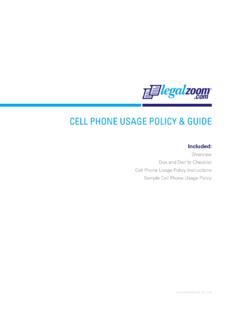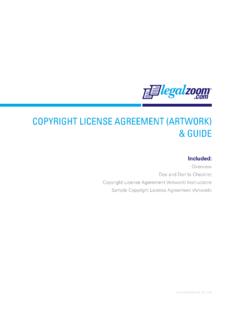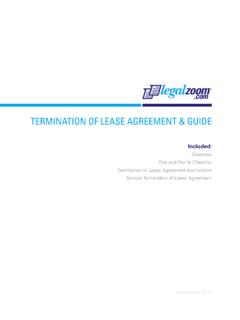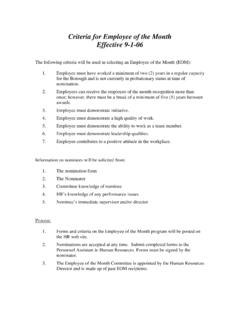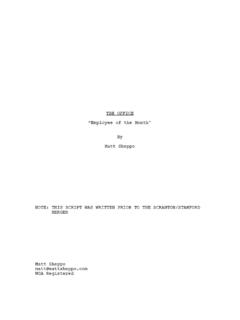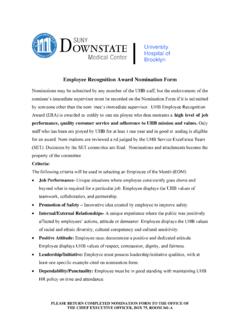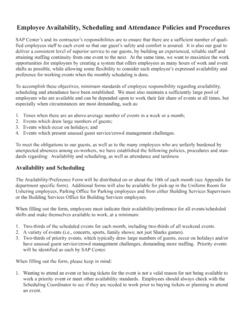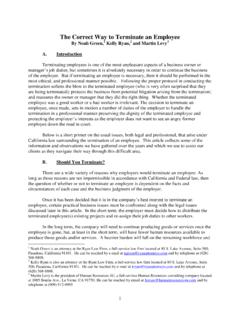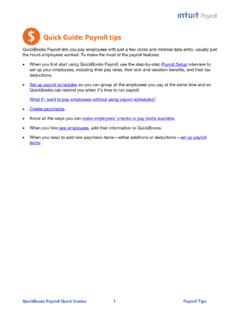Transcription of EMPLOYEE TERMINATION LETTER & GUIDE
1 EMPLOYEE TERMINATION LETTER & GUIDEI ncluded:Overview Dos and Don ts Checklist EMPLOYEE TERMINATION LETTER Instructions Sample EMPLOYEE TERMINATION LETTER , INC. 2008 1 EMPLOYEE TERMINATION LETTER , INC. 2008 1. OverviewAt some point in the life of every organization, managers will need to fire employees. There may be any number of reasons for such decisions, from downsizing and misconduct, to breaches of company policy or poor performance. Without a written employment agreement or a specific state-granted right, employment is considered to be at will and can be terminated with or without cause or notice. If employment is at will, a TERMINATION LETTER can be used to end the employment relationship, setting forth the details and reasons for the TERMINATION , and specifying any severance package that will follow. An EMPLOYEE TERMINATION LETTER must be clear and concise, and should include all relevant information about the arrangement.
2 If the EMPLOYEE has a contract with the company, employers should be aware of and fulfill any obligations they may have under that agreement before looking to terminate an EMPLOYEE . In some cases, early notice may be required and a well-crafted TERMINATION LETTER can provide that notice while protecting the employer from lawsuits down the document contains the essential elements of an EMPLOYEE TERMINATION LETTER . It is designed for easy revision and reuse with future employees. If you follow the guidelines provided, you can use this LETTER effectively in your business and protect yourself from costly and time-consuming lawsuits down the road. 2. Dos & Don ts Checklist If you are firing an EMPLOYEE , it is essential to conduct the TERMINATION carefully, following all internal policies and local laws. Improper or careless actions may subject your company to unlawful TERMINATION lawsuits, costing the organization considerable time and money.
3 In the end, you may face large fines and be forced to rehire the terminated EMPLOYEE . Before sitting down to draft a TERMINATION LETTER , review all records relating to the EMPLOYEE in question, including personnel files, letters, employment agreements, reviews and evaluations. Make sure you understand the reasons for the TERMINATION and the legal or contractual requirements you must follow. Employment is usually at-will, unless a specific agreement or law says otherwise. At-will employment can be terminated by either party, at any time, with or without cause. If you aren t sure whether the employment relationship was at will, review all of your correspondence with the EMPLOYEE , signed orientation materials or handbooks, union rules, personnel files and employment agreements. If any of these contain phrases like you will be terminated only for good cause, the employment may not be considered at will.
4 Even if the employment was at-will, it can t be terminated for unlawful reasons ( , jury duty, personal bankruptcy, reports of unlawful activities, etc.). Talk to an employment lawyer or human resources professional if you are unsure whether or not the employment relationship is at will or your reasons for TERMINATION are TERMINATION LETTER , INC. 2008 In many areas, if employment is terminated with cause, the employer does not need to provide notice or pay any additional compensation. However, the employer must be sure that these causes are spelled out ( , drug use, absenteeism, sexual harassment, etc.). If TERMINATION is without cause, an employer is usually required to provide notice and may be required to pay certain amounts to the former EMPLOYEE . The required amount of notice and compensation varies from state to state, industry to industry, and EMPLOYEE to EMPLOYEE .
5 If you are required to give TERMINATION notice in a certain way or within a certain period of time ( , some employers are required to give 60 days notice of closings and layoffs under federal law), make sure you provide notice according to these requirements. Review your local laws for additional details. If the terminated EMPLOYEE brings a lawsuit, the employer may be forced to defend itself against charges that the dismissal was illegal. Make sure you have satisfied all contractual and statutory requirements before starting the TERMINATION process. Keep copies of all relevant documents these may be needed to establish the legitimate reasons for the TERMINATION . For example, if the TERMINATION was based on poor work performance, keep notes of any supervisor reviews or warnings given to the terminated EMPLOYEE . The employer must pay any wages owed to the EMPLOYEE promptly after TERMINATION .
6 Many states have specific laws about the amount of time the employer has to make this payment. Review your state s laws for additional information about requirements in your area. A TERMINATION may start certain obligations under a non-disclosure agreement. If you include a non-disclosure clause in your LETTER , remember that many states require such clauses to be reasonable. What is considered reasonable varies from state to state, and you should speak with a human resources professional in your area to see what limitations may apply. Although not required by law, employers may decide to give severance pay to a terminated EMPLOYEE . Severance pay is simply money paid at the time of an EMPLOYEE s departure from a company, and is usually offered if the TERMINATION is a result of layoffs, job elimination, or mutual agreement. If you are offering severance as part of the TERMINATION , make sure that the EMPLOYEE provides a release in return for this payment.
7 A release is the EMPLOYEE s promise not to bring a lawsuit against the company because of his or her TERMINATION . Severance pay provided in exchange for a release must be money over and above what the EMPLOYEE is already entitled to. For example, if the EMPLOYEE s agreement already provides that he or she will receive 2 weeks pay at the time of TERMINATION , the EMPLOYEE must receive both that 2 weeks pay and severance pay. The LETTER should not include anything biased, discriminatory, or unfair. Include basic facts and the specific reasons behind the TERMINATION . Language should be professional and courteous, and you should never use insulting, derogatory, or demeaning content: remember, these letters may be used as evidence in a court of law. 3 EMPLOYEE TERMINATION LETTER , INC. 2008 Keep the language as objective as possible, and look for measurable, verifiable, equitable, and understandable means of explaining your decision.
8 You are not measuring the EMPLOYEE s personality you are measuring their level of performance. Focus on specific criteria like absenteeism rate, the number of incomplete projects, or the number of customer complaints. After you ve written the LETTER , review it to ensure that all relevant points have been included, but make sure it stays short and factual. Unnecessary details may provide more opportunities for rebuttal or dispute. After the TERMINATION , disable the EMPLOYEE s passwords and modify those of any close co-workers. If the terminated EMPLOYEE knows any company passwords, it may be a good idea to cancel or change those as well. Before forwarding the EMPLOYEE s final paycheck, make sure he or she has retuned all company documents, equipment, cars, keys, procedure manuals, credit cards, ID cards, and access badges. Ask the EMPLOYEE to sign a copy of the LETTER , acknowledging that it was received.
9 If he or she refuses, have a witness sign indicating that he or she witnessed that refusal. In any event, it is a good idea to have a witness from the company with you when you hand over the LETTER and during any exit interviews conducted. Make several copies of the LETTER , and give one to the EMPLOYEE at the end of the discussion. Place an additional copy in the EMPLOYEE s personnel file. If the situation is complicated, or if you feel there may be a legal battle about the TERMINATION , do not use the enclosed form. Contact an attorney to help you draft a document that will meet your specific needs. 3. EMPLOYEE TERMINATION LETTER InstructionsThe following instructions will help you understand the terms of your TERMINATION LETTER . The numbers below correspond to numbers in the LETTER . Please review the entire document before starting the step-by-step process.
10 1. Enter the name of your company and the effective date of the TERMINATION in the blanks provided. 2. Explain why you are terminating the EMPLOYEE . If the TERMINATION is for cause, this may be reasons such as general misconduct, poor performance, alcohol use, or absenteeism. Describe any warnings that were given and how many, if any, opportunities your company gave the EMPLOYEE to fix the An optional paragraph, which may be required depending on local laws and any applicable employment agreement. It explains that the EMPLOYEE has been given notice of the TERMINATION as required by law or agreement. You may wish to fill in the details of the notice, including the date and manner in which it was given. If the employment relationship is governed by a contract, include information about the notice requirements (if any) set forth in that agreement.
